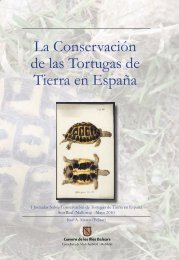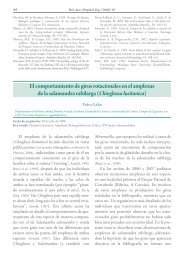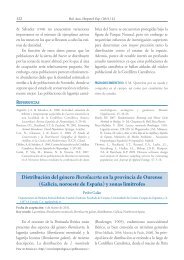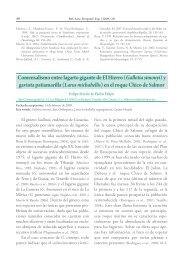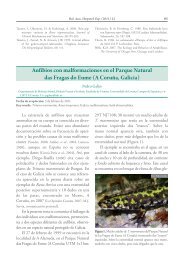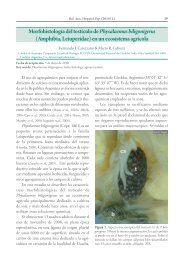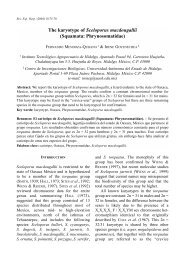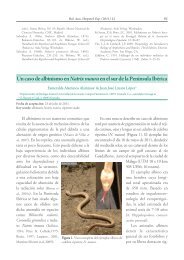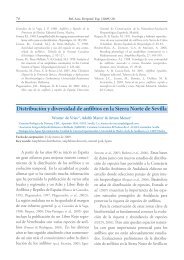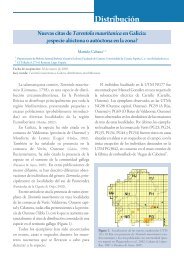Seasonal and ontogenetic variation in diet composition of ...
Seasonal and ontogenetic variation in diet composition of ...
Seasonal and ontogenetic variation in diet composition of ...
Create successful ePaper yourself
Turn your PDF publications into a flip-book with our unique Google optimized e-Paper software.
Rev. Esp. Herp. (2004) 18:19-28<br />
<strong>Seasonal</strong> <strong>and</strong> <strong>ontogenetic</strong> <strong>variation</strong> <strong>in</strong> <strong>diet</strong> <strong>composition</strong> <strong>of</strong><br />
Leptodactylus podicip<strong>in</strong>us (Anura, Leptodactylidae)<br />
<strong>in</strong> the southern Pantanal, Brazil<br />
DOMINGOS DE J. RODRIGUES, 1 MASAO UETANABARO 1 & CYNTHIA P.A. PRADO, 1, 2<br />
1 Departamento de Biologia, Universidade Federal de Mato Grosso do Sul,<br />
Caixa Postal 549, 79070-900, Campo Gr<strong>and</strong>e, MS, Brazil<br />
(e-mail: poxo@<strong>in</strong>pa.gov.br)<br />
2 Departamento de Zoologia, Instituto de Biociências, Universidade Estadual Paulista,<br />
Caixa Postal 199, 13506-900, Rio Claro, SP, Brazil<br />
Abstract: The forag<strong>in</strong>g strategies <strong>of</strong> amphibians allow them to capture a wide variety <strong>of</strong> prey, <strong>diet</strong><br />
<strong>variation</strong> be<strong>in</strong>g generally associated with morphological, physiological, <strong>and</strong> behavioral traits that<br />
facilitate the location, identification, <strong>and</strong> digestion <strong>of</strong> food items. Here<strong>in</strong> we present the <strong>diet</strong> <strong>composition</strong><br />
<strong>of</strong> L. podicip<strong>in</strong>us <strong>and</strong> <strong>variation</strong>s regard<strong>in</strong>g the number <strong>and</strong> type <strong>of</strong> prey consumed by juveniles, males<br />
<strong>and</strong> females dur<strong>in</strong>g the wet <strong>and</strong> dry seasons, <strong>in</strong> the southern Pantanal, Brazil. Sampl<strong>in</strong>g was conducted<br />
at three different times dur<strong>in</strong>g the dry season, <strong>and</strong> three different times dur<strong>in</strong>g the wet season between<br />
June 1998 <strong>and</strong> May 1999. The quantitative analysis showed that the <strong>diet</strong> <strong>of</strong> L. podicip<strong>in</strong>us is composed<br />
ma<strong>in</strong>ly by Coleoptera (51.0%), Hymenoptera (9.1%), Diptera (8.7%), Aranae (5.3%), <strong>and</strong> Orthoptera<br />
(4.7%). In the wet season, males captured more prey than juveniles <strong>and</strong> females, but <strong>in</strong> the dry season<br />
there were no differences. Males <strong>and</strong> females <strong>in</strong>gested larger prey compared to juveniles. The frog<br />
L. podicip<strong>in</strong>us is an opportunist <strong>and</strong> generalist predator, <strong>and</strong> the availability <strong>of</strong> prey <strong>in</strong> the environment<br />
may be an important factor determ<strong>in</strong><strong>in</strong>g its <strong>diet</strong> <strong>composition</strong> <strong>in</strong> the Pantanal.<br />
Key words: <strong>diet</strong>, Leptodactylus podicip<strong>in</strong>us, <strong>ontogenetic</strong> <strong>diet</strong> shift, Pantanal, seasonality.<br />
Resumen: Variación estacional y ontogenética en la composición de la <strong>diet</strong>a de Leptodactylus<br />
podicip<strong>in</strong>us (Anura, Leptodactylidae) en el sur del Pantanal, Brasil. – Las estrategias de forrajeo de<br />
los anfibios les permiten capturar una amplia variedad de presas, y las variaciones en su <strong>diet</strong>a están en<br />
general relacionadas con caracteres morfológicos, fisiológicos y de comportamiento que les facilitan la<br />
localización, identificación y digestión del alimento. Aquí presentamos datos sobre la composición de<br />
la <strong>diet</strong>a en L. podicip<strong>in</strong>us y las variaciones en el número y tipo de presas que consumen los juveniles,<br />
los machos y las hembras durante las estaciones seca y húmeda en el sur del Pantanal, Brasil. Se<br />
obtuvieron muestras en tres momentos dist<strong>in</strong>tos durante la estación seca y otros tres durnate la estación<br />
húmeda entre junio de 1998 y mayo de 1999. El análisis cuantitativo demostró que la <strong>diet</strong>a de<br />
L. podicip<strong>in</strong>us está compuesta fundamentalmente por Coleoptera (51.0%), Hymenoptera (9.1%),<br />
Diptera (8.7%), Aranae (5.3%) y Orthoptera (4.7%). Durante la estación húmeda, los machos capturaron<br />
más presas que los juveniles y que las hembras, pero no se observaron diferencias durante la estación<br />
seca. Los machos y las hembras <strong>in</strong>girieron presas de mayor tamaño que los juveniles. La rana<br />
L. podicip<strong>in</strong>us es un depredador oportunista y generalista, y la disponibilidad de presas en su ambiente<br />
puede ser un factor determ<strong>in</strong>ante de la composición de su <strong>diet</strong>a en el Pantanal.<br />
Palabras clave: cambio ontogenético de <strong>diet</strong>a, <strong>diet</strong>a, estacionalidad, Leptodactylus podicip<strong>in</strong>us, Pantanal.
20<br />
D.J. RODRIGUES et al.<br />
INTRODUCTION<br />
The forag<strong>in</strong>g strategies <strong>of</strong> amphibians allow<br />
them to capture a wide variety <strong>of</strong> prey<br />
(STEBBINS & COHEN, 1995). Studies on the<br />
<strong>diet</strong> <strong>of</strong> anurans through the analysis <strong>of</strong><br />
stomach contents demonstrate that most<br />
species feed on arthropods, be<strong>in</strong>g considered<br />
generalists (e.g. TOFT, 1980b; WERNER et al.,<br />
1995; VAN SLUYS & ROCHA, 1998).<br />
Nevertheless, some species consume small<br />
vertebrates (DUELLMAN & TRUEB, 1986),<br />
whereas others are considered herbivores<br />
(e.g. SILVA et al., 1989; DAS, 1996). In<br />
general, their <strong>diet</strong> is associated with<br />
morphological, physiological, <strong>and</strong> behavioral<br />
traits that facilitate the location,<br />
identification, <strong>and</strong> digestion <strong>of</strong> food items<br />
(e.g. MEDDEB & CHENITI, 1998; CALDWELL &<br />
VITT, 1999; BELLOCQ et al., 2000).<br />
Most amphibians are generalists <strong>and</strong><br />
opportunists, <strong>and</strong> prey availability is the<br />
dom<strong>in</strong>ant factor determ<strong>in</strong><strong>in</strong>g their <strong>diet</strong>, along<br />
with the constra<strong>in</strong>ts provided by the<br />
prey/predator size relationship (e.g.<br />
MACNAMARA, 1977; POUGH et al., 1998).<br />
There are, however, some species <strong>of</strong><br />
amphibians that can be considered specialists,<br />
select<strong>in</strong>g the prey items to be consumed (e.g.<br />
LIEBERMAN, 1986; SIMON & TOFT, 1991; DAS,<br />
1996).<br />
Generally, anurans are classified <strong>in</strong>to two<br />
groups depend<strong>in</strong>g on the forag<strong>in</strong>g strategy<br />
adopted (e.g. TOFT, 1981; STRÜSSMANN et al.,<br />
1984; LIMA & MOREIRA, 1993): widely<br />
foragers, <strong>and</strong> sit-<strong>and</strong>-wait foragers. Active<br />
foragers usually feed on small, aggregated<br />
prey (ants <strong>and</strong> termites), <strong>and</strong> are considered<br />
specialists, whereas the sedentary foragers<br />
feed upon larger prey, <strong>and</strong> have a more<br />
generalist <strong>and</strong> opportunistic <strong>diet</strong> (LIMA &<br />
MOREIRA, 1993).<br />
Variation <strong>in</strong> the <strong>diet</strong> <strong>of</strong> anurans also occurs<br />
due to <strong>ontogenetic</strong> changes (POUGH et al.,<br />
1998), ma<strong>in</strong>ly regard<strong>in</strong>g the type <strong>and</strong> size <strong>of</strong><br />
prey (e.g. WOOLBRIGHT & STEWART, 1987;<br />
WIGGINS, 1992; LIMA & MOREIRA, 1993). The<br />
mechanisms responsible for this <strong>ontogenetic</strong><br />
<strong>variation</strong> have not yet been elucidated, but an<br />
important part <strong>of</strong> the differences regard<strong>in</strong>g<br />
type <strong>and</strong> size <strong>of</strong> prey chosen by adult<br />
amphibians when compared to juveniles<br />
reflects changes <strong>in</strong> forag<strong>in</strong>g methods (e.g.<br />
TOFT, 1981; OVASKA, 1991), as well as<br />
changes <strong>in</strong> predator size (e.g. STRÜSSMANN et<br />
al., 1984; LIMA & MOREIRA, 1993).<br />
The Pantanal is a floodpla<strong>in</strong> that possesses<br />
a variable precipitation regime, lead<strong>in</strong>g to a<br />
regular cycle <strong>of</strong> ris<strong>in</strong>g <strong>and</strong> lower<strong>in</strong>g <strong>of</strong> the<br />
water level (LOURIVAL et al., 2000). The<br />
annual floods allow some lotic habitats to mix<br />
regularly, while some microhabitats rema<strong>in</strong><br />
isolated for up to 50-100 years, develop<strong>in</strong>g<br />
peculiar characteristics until a great flood<br />
mixes them aga<strong>in</strong>. This makes the Pantanal an<br />
ideal region for conduct<strong>in</strong>g research on <strong>diet</strong>s,<br />
especially associated to the <strong>variation</strong>s on the<br />
availability <strong>of</strong> prey related to the local<br />
seasonality.<br />
Studies on anuran <strong>diet</strong>s <strong>in</strong> the Pantanal are<br />
nonexistent, <strong>and</strong> the few studies that do exist<br />
refer to prelim<strong>in</strong>ary species lists, taxonomic<br />
comments, <strong>and</strong> studies on the biology <strong>and</strong><br />
reproductive strategies (e.g. PRADO &<br />
UETANABARO, 2000; PRADO et al., 2000, 2002;<br />
STRÜSSMANN et al., 2000). Leptodactylus<br />
podicip<strong>in</strong>us is a nocturnal, medium-sized<br />
frog, widely distributed <strong>in</strong> open formations <strong>of</strong><br />
Brazil, Bolivia, Paraguay <strong>and</strong> Argent<strong>in</strong>a<br />
(HEYER, 1994), <strong>and</strong> is very common at the<br />
study site. Reproduction occurs throughout<br />
the year <strong>in</strong> the southern Pantanal, associated<br />
with the marg<strong>in</strong>s <strong>of</strong> permanent <strong>and</strong> temporary<br />
lagoons, where the males build small<br />
depressions dest<strong>in</strong>ed for egg-lay<strong>in</strong>g (PRADO et<br />
al., 2002). The present work studied the <strong>diet</strong><br />
<strong>composition</strong> <strong>of</strong> L. podicip<strong>in</strong>us <strong>in</strong> the southern<br />
Pantanal, State <strong>of</strong> Mato Grosso do Sul, Brazil,
DIET OF Leptodactylus podicip<strong>in</strong>us 21<br />
<strong>and</strong> analyzed the <strong>variation</strong> <strong>in</strong> size <strong>and</strong> number<br />
<strong>of</strong> prey consumed by juveniles, males, <strong>and</strong><br />
females. These comparisons took <strong>in</strong>to<br />
account the seasonal climate <strong>of</strong> the region,<br />
consider<strong>in</strong>g the dry <strong>and</strong> wet seasons<br />
separately.<br />
MATERIALS AND METHODS<br />
Study area<br />
The Pantanal can be divided <strong>in</strong>to at least<br />
10 different subregions, each with its own<br />
physiognomy result<strong>in</strong>g from a unique<br />
<strong>in</strong>teraction <strong>of</strong> edaphic, hydrological, <strong>and</strong><br />
biogeographical factors (LOURIVAL et al.,<br />
2000). Here<strong>in</strong> we follow ADÁMOLI (1982),<br />
who proposed 10 subregions for the Pantanal:<br />
Cáceres, Poconé, Barão de Melgaço,<br />
Paiaguás, Nhecolândia, Aquidauna, Paraguai,<br />
Mir<strong>and</strong>a, Nabileque, <strong>and</strong> Abobral. Accord<strong>in</strong>g<br />
to TARIFA (1986), the mean monthly<br />
temperatures range from 19.9ºC (July) to<br />
27.4ºC (December), with frequent chills<br />
reach<strong>in</strong>g 10ºC that last 2-3 days, usually<br />
between April <strong>and</strong> September. Ra<strong>in</strong>fall is<br />
considered low <strong>in</strong> the region, with an annual<br />
mean <strong>of</strong> 972 mm. Floods are common<br />
between January <strong>and</strong> April, <strong>and</strong> are not<br />
related to local ra<strong>in</strong>fall but are associated with<br />
reduced dra<strong>in</strong>age (AMARAL FILHO, 1986). The<br />
plant cover <strong>of</strong> the site is represented by native<br />
grassy fields, semideciduous forest patches<br />
(“capões” <strong>and</strong> “cordilheiras”), riparian<br />
forests, <strong>and</strong> monospecific formations <strong>of</strong><br />
Tabebuia aurea (“paratudal”; Bignoniaceae)<br />
or Copernicia australis (“car<strong>and</strong>azal”;<br />
Palmae).<br />
Data collection<br />
The study was conducted <strong>in</strong> the Pantanal<br />
<strong>of</strong> Abobral, municipality <strong>of</strong> Corumbá, State<br />
<strong>of</strong> Mato Grosso do Sul, Brazil (19º 34’ S, 57º<br />
00’ W). Individuals were captured at the<br />
marg<strong>in</strong>s <strong>of</strong> water bodies, flooded fields, <strong>and</strong><br />
“borrow<strong>in</strong>g boxes” (depressions formed by<br />
soil removal for construction purposes).<br />
Three samples were obta<strong>in</strong>ed dur<strong>in</strong>g the<br />
dry season (September, October <strong>and</strong><br />
November 1999) <strong>and</strong> three dur<strong>in</strong>g the wet<br />
season (June <strong>and</strong> July 1998, <strong>and</strong> May 1999).<br />
Collect<strong>in</strong>g always started two hours after<br />
sunset, <strong>and</strong> was done with the aid <strong>of</strong> an<br />
electric flashlight. Collect<strong>in</strong>g effort <strong>of</strong> 2h<br />
rema<strong>in</strong>ed constant. Specimens were collected<br />
at r<strong>and</strong>om, fixed <strong>in</strong> 10% formal<strong>in</strong> while still<br />
<strong>in</strong> the field for immediate cessation <strong>of</strong><br />
digestion, <strong>and</strong> later preserved <strong>in</strong> 70% ethanol.<br />
The material was deposited <strong>in</strong> the Coleção<br />
Zoológica <strong>of</strong> the Universidade Federal de<br />
Mato Grosso do Sul.<br />
The snout-vent length (SVL) <strong>of</strong><br />
<strong>in</strong>dividuals was measured with precision<br />
calipers to the nearest 0.1 mm. For the study<br />
<strong>of</strong> <strong>diet</strong> <strong>variation</strong>, specimens were separated <strong>in</strong><br />
classes: juveniles, males <strong>and</strong> females. Due to<br />
sexual size dimorphism (PRADO et al., 2000),<br />
males smaller than 26 mm <strong>and</strong> females<br />
smaller than 32 mm were considered as<br />
juveniles. Adults were sexed by exam<strong>in</strong>ation<br />
<strong>of</strong> the external morphology (presence <strong>of</strong><br />
vocal sacs <strong>and</strong> nuptial sp<strong>in</strong>es <strong>in</strong> males) <strong>and</strong><br />
gonads.<br />
Stomachs were removed through a<br />
longitud<strong>in</strong>al abdom<strong>in</strong>al <strong>in</strong>cision <strong>and</strong><br />
preserved <strong>in</strong> 70% ethanol. Stomach contents<br />
were analyzed separately for sex <strong>and</strong> size<br />
classes under a stereomicroscope. Items<br />
were quantified, measured (length) with<br />
precision calipers, <strong>and</strong> identified up to Order<br />
level. We tested for <strong>variation</strong>s <strong>in</strong> number <strong>and</strong><br />
size <strong>of</strong> prey between seasons (dry / wet) <strong>and</strong><br />
size classes (juvenile, male, <strong>and</strong> female)<br />
us<strong>in</strong>g a two way ANOVA (α = 0.05). If<br />
differences were detected by ANOVA, a<br />
Tukey test was then conducted. The number<br />
<strong>and</strong> size <strong>of</strong> prey per stomach were logtransformed<br />
<strong>in</strong> order to homogenize the<br />
variances.
22<br />
D.J. RODRIGUES et al.<br />
RESULTS<br />
Of 189 stomachs analyzed, 155 conta<strong>in</strong>ed<br />
food items, while only 34 were empty (19<br />
juveniles <strong>and</strong> 15 adults). Food items <strong>in</strong> an<br />
advanced stage <strong>of</strong> digestion were found <strong>in</strong> 31<br />
stomachs <strong>and</strong> were not identified. The mean<br />
SVL <strong>of</strong> juveniles was 22.4 ± 4.4 mm (N = 81;<br />
range = 11.5-31.8), that <strong>of</strong> males was 32.2 ±<br />
3.4 mm (N = 55; range = 26.0-39.0), <strong>and</strong><br />
females averaged 38.0 ± 3.7 mm (N = 53;<br />
range = 32.0-47.0). The quantitative analysis<br />
<strong>of</strong> the <strong>diet</strong> <strong>of</strong> L. podicip<strong>in</strong>us revealed that it<br />
was composed ma<strong>in</strong>ly by arthropods (Table<br />
1). The most frequent prey group was<br />
Coleoptera (51%), followed by Hymenoptera<br />
(9.1%), Diptera (8.7%), Aranae (5.3%), <strong>and</strong><br />
Orthoptera (4.7%; Fig. 1). Chilopoda (3),<br />
Diplopoda (1), Isopoda (1), Lepidoptera (1),<br />
Mollusca (1), <strong>and</strong> Odonata larvae (2)<br />
occurred <strong>in</strong> low frequencies <strong>in</strong> the stomachs<br />
analyzed.<br />
The number <strong>of</strong> prey consumed by L.<br />
podicip<strong>in</strong>us differed significantly among size<br />
classes (ANOVA: F 2,158<br />
= 3.51, p = 0.030).<br />
There was a significant <strong>in</strong>teraction between<br />
period <strong>and</strong> size classes (ANOVA: F 2,158<br />
=<br />
3.33, p = 0.039), but there were no significant<br />
differences between periods (ANOVA: F 1,158<br />
= 0.72, p = 0.39). Males consumed, on<br />
average, more items than females (Tukey =<br />
0.318, p = 0.031) <strong>and</strong> juveniles (Tukey =<br />
0.271, p = 0.022; Fig. 2) dur<strong>in</strong>g the wet<br />
season (Table 2).<br />
Prey size also differed among size classes<br />
(ANOVA: F 2,120<br />
= 10.86, p < 0.001), but there<br />
were no significant differences between<br />
periods (ANOVA: F 1,120<br />
= 2.231, p = 0.001).<br />
Females consumed larger prey items than<br />
juveniles <strong>in</strong> the dry season (Tukey = 0.517, p<br />
= 0.003), <strong>and</strong> <strong>in</strong> the wet season males <strong>and</strong><br />
females consumed larger items than juveniles<br />
(Tukey = 0.467, p = 0.010 <strong>and</strong> Tukey = 0.575,<br />
p = 0.000, respectively; Fig. 3).<br />
TABLE 1. Total occurrence (TO) <strong>and</strong> frequency (Fr) <strong>of</strong> prey<br />
items recorded (phylum, class <strong>and</strong> order) <strong>in</strong> the stomachs <strong>of</strong><br />
L. podicip<strong>in</strong>us <strong>in</strong> the southern Pantanal dur<strong>in</strong>g dry <strong>and</strong> wet<br />
seasons. N = nymphs, L = larvae.<br />
TABLA 1. Ocurrencia total (TO) y frecuencia (Fr) de las presas<br />
registradas (phylum, clase y orden) en los estómagos de<br />
L. podicip<strong>in</strong>us en el sur del Pantanal durante las estaciones<br />
seca y húmeda. N = n<strong>in</strong>fas, L = larvas.<br />
Dry Wet TO Fr (%)<br />
Annelida<br />
Oligochaeta 1 1 2 0.41<br />
Arthropoda<br />
Arachnida<br />
Acar<strong>in</strong>a 1 – 1 0.20<br />
Araneida 10 16 26 5.30<br />
Crustacea<br />
Decapoda 12 – 12 2.45<br />
Isopoda 1 – 1 0.20<br />
Insecta<br />
Blattodea 5 – 5 1.01<br />
Blattodea (N) 1 – 1 0.20<br />
Dermaptera 3 – 3 0.62<br />
Dermaptera (N) – 1 1 0.20<br />
Ephemeroptera – 1 1 0.20<br />
Lepidoptera 1 – 1 0.20<br />
Lepidoptera (L) 9 2 11 2.20<br />
Orthoptera 13 10 23 4.65<br />
Orthoptera (N) 2 – 2 0.41<br />
Odonata (L) – 2 2 0.41<br />
Diptera 16 27 43 8.70<br />
Coleoptera 127 125 252 51.00<br />
Coleoptera (L) 4 3 7 1.41<br />
Hemiptera 4 3 7 1.41<br />
Homoptera 4 8 12 2.41<br />
Hymenoptera 26 19 45 9.10<br />
Miriapoda<br />
Diplopoda 1 – 1 0.20<br />
Chilopoda 2 1 3 0.61<br />
Mollusca – 1 1 0.20<br />
Undeterm<strong>in</strong>ed 24 7 31 6.30<br />
Total 494 100
DIET OF Leptodactylus podicip<strong>in</strong>us 23<br />
FIGURE 1. Number <strong>of</strong> prey items (%) <strong>in</strong> the <strong>diet</strong> <strong>of</strong> L.<br />
podicip<strong>in</strong>us <strong>in</strong> the southern Pantanal, Brazil. Ara: Aranae,<br />
Col: Coleoptera, Dip: Diptera, Hym: Hymenoptera, Ort:<br />
Orthoptera, Oth: other.<br />
FIGURA 1. Número de presas (%) en la <strong>diet</strong>a de L.<br />
podicip<strong>in</strong>us en el sur del Pantanal, Brasil. Ara: Aranae, Col:<br />
Coleoptera, Dip: Diptera, Hym: Hymenoptera, Ort:<br />
Orthoptera, Oth: otras.<br />
Coleoptera appeared <strong>in</strong> larger quantities <strong>in</strong><br />
the stomachs dur<strong>in</strong>g both seasons (Table 1).<br />
However, some food items, such as mites,<br />
crustaceans, diplopods, <strong>and</strong> isopods,<br />
appeared <strong>in</strong> only one season (Table 1).<br />
Ingestion <strong>of</strong> plant material <strong>and</strong> s<strong>and</strong> was also<br />
recorded.<br />
DISCUSSION<br />
Leptodactylids are considered sit-<strong>and</strong>-wait<br />
generalist predators, <strong>and</strong> thus more efficient<br />
<strong>in</strong> the capture <strong>of</strong> prey such as Orthoptera <strong>and</strong><br />
Coleoptera (e.g. TOFT, 1980a, 1981; PERRY et<br />
al., 1990; LIMA & MOREIRA, 1993; POUGH et<br />
al., 1998). In the present study, Leptodactylus<br />
podicip<strong>in</strong>us seems to be a generalist predator,<br />
because its <strong>diet</strong> is composed by different food<br />
items, ma<strong>in</strong>ly arthropods. GALATTI (1992)<br />
<strong>and</strong> TOFT (1981, 1995) showed that<br />
consumption <strong>of</strong> some prey types by L.<br />
pentadactylus <strong>and</strong> Epipedobates femoralis<br />
was directly proportional to their availability<br />
<strong>in</strong> the environment, which could expla<strong>in</strong> the<br />
large occurrence <strong>of</strong> Coleoptera <strong>in</strong> the <strong>diet</strong> <strong>of</strong><br />
L. podicip<strong>in</strong>us. This order is the most<br />
abundant among the <strong>in</strong>sects <strong>and</strong> is easily<br />
FIGURE 2. Mean ± SE <strong>of</strong> log <strong>of</strong> number <strong>of</strong> prey by stomach<br />
consumed by juveniles (63), females (49), <strong>and</strong> males (46) <strong>of</strong><br />
L. podicip<strong>in</strong>us dur<strong>in</strong>g the dry <strong>and</strong> wet seasons <strong>in</strong> the<br />
southern Pantanal, Brazil.<br />
FIGURA 2. Media ± SE del logaritmo del número de presas<br />
por estómago <strong>in</strong>geridas por juveniles (63), hembras (49), y<br />
machos (46) de L. podicip<strong>in</strong>us durante las estaciones seca y<br />
húmeda en el sur del Pantanal, Brasil.<br />
found <strong>in</strong> almost all habitats (BORROR &<br />
DELONG, 1969). The <strong>in</strong>gestion <strong>of</strong> large fleshy<br />
items, such as larvae <strong>of</strong> Odonata (27 mm) <strong>and</strong><br />
Lepidoptera (27 mm), likewise suggests<br />
opportunism <strong>in</strong> L. podicip<strong>in</strong>us. However,<br />
s<strong>in</strong>ce we did not estimate the availability <strong>of</strong><br />
prey <strong>in</strong> the environment, <strong>and</strong> consider<strong>in</strong>g that<br />
more than 50% <strong>of</strong> the <strong>diet</strong> <strong>of</strong> L. podicip<strong>in</strong>us<br />
was composed by Coleoptera, we should be<br />
cautious <strong>in</strong> stat<strong>in</strong>g that this species is totally<br />
generalist. The results obta<strong>in</strong>ed could be due<br />
to prey selection, or could be due to behavior<br />
<strong>and</strong> microhabitat use (ma<strong>in</strong>ly lagoon<br />
marg<strong>in</strong>s) facilitat<strong>in</strong>g the encounter with this<br />
type <strong>of</strong> prey.<br />
Ontogenetic changes <strong>in</strong> the <strong>diet</strong> <strong>of</strong> anurans<br />
occur regard<strong>in</strong>g type <strong>and</strong> size <strong>of</strong> prey, ma<strong>in</strong>ly<br />
due to an <strong>in</strong>crease <strong>in</strong> predator size (e.g.<br />
STRÜSSMANN et al., 1984; WOOLBRIGHT &
24<br />
D.J. RODRIGUES et al.<br />
TABLE 2. Mean ± SE number <strong>of</strong> prey <strong>and</strong> prey size <strong>in</strong> the stomachs <strong>of</strong> L. podicip<strong>in</strong>us dur<strong>in</strong>g dry <strong>and</strong> wet seasons <strong>in</strong> the<br />
southern Pantanal, Brazil. N = number <strong>of</strong> stomachs analyzed.<br />
TABLA 2. Media ± SE del número y tamaño de las presas en los estómagos de L. podicip<strong>in</strong>us durante las estaciones seca y<br />
húmeda en el sur del Pantanal, Brasil. N = número de estómagos analizados.<br />
Number <strong>of</strong> prey<br />
Prey size<br />
Dry Wet Dry Wet<br />
N x±SE N x±SE N x±SE N x±SE<br />
Females 33 3.30 ± 0.62 16 2.00 ± 0.34 29 6.69 ± 0.61 11 5.55 ± 0.76<br />
Males 26 3.35 ± 0.58 20 5.15 ± 1.08 20 5.85 ± 0.61 17 5.12 ± 0.46<br />
Juveniles 24 2.96 ± 0.33 39 2.41 ± 0.38 18 4.33 ± 0.86 25 3.76 ± 0.33<br />
STEWART, 1987; OVASKA, 1991; WIGGINS,<br />
1992; LIMA & MOREIRA, 1993). BRYUN et al.<br />
(1996) observed <strong>ontogenetic</strong> changes <strong>in</strong> type<br />
<strong>and</strong> size <strong>of</strong> prey <strong>of</strong> Xenopus fraseri, <strong>and</strong> such<br />
changes were also observed <strong>in</strong> Colostethus<br />
stepheni (LIMA & MOREIRA, 1993) <strong>and</strong><br />
Eleutherodactylus johnstoni (OVASKA, 1991).<br />
TOFT (1981), study<strong>in</strong>g the forag<strong>in</strong>g method <strong>of</strong><br />
anurans <strong>in</strong> Panama <strong>and</strong> Peru, noted that body<br />
size is highly correlated with prey size <strong>in</strong> 20<br />
species <strong>of</strong> litter frogs. WOOLBRIGHT &<br />
STEWART (1987), study<strong>in</strong>g Eleutherodactylus<br />
coqui, <strong>and</strong> DONNELY (1991), study<strong>in</strong>g<br />
Dendrobates pumilio, found the same<br />
relationship. VAN SLUYS et al. (2001) found a<br />
significant positive relationship between<br />
mouth size <strong>and</strong> number <strong>of</strong> prey consumed by<br />
the litter frog Zachaenus parvulus <strong>in</strong> the<br />
Atlantic Forest, southeastern Brazil.<br />
Ontogenetic changes were also observed for<br />
L. podicip<strong>in</strong>us <strong>in</strong> the present study, s<strong>in</strong>ce<br />
males <strong>and</strong> females consumed more <strong>and</strong> larger<br />
prey than juveniles. However, other factors<br />
such as the forag<strong>in</strong>g method adopted<br />
(DUELMANN & TRUEB, 1986), change <strong>of</strong><br />
substrate (TOFT, 1980b), capture efficiency,<br />
<strong>and</strong> seasonal <strong>variation</strong> <strong>in</strong> <strong>composition</strong> <strong>and</strong><br />
abundance <strong>of</strong> prey (DONELLY, 1991; STEBBINS<br />
& COHEN, 1995) could also expla<strong>in</strong> the<br />
occurrence <strong>of</strong> <strong>ontogenetic</strong> changes <strong>in</strong> anuran<br />
<strong>diet</strong>s.<br />
Females <strong>of</strong> L. podicip<strong>in</strong>us were larger than<br />
males, which is common <strong>in</strong> anurans (CRUMP,<br />
1974; SHINE, 1979). However, females did not<br />
consume larger prey or <strong>in</strong> greater amounts<br />
than males <strong>and</strong>, <strong>in</strong> contrast, males <strong>of</strong> L.<br />
podicip<strong>in</strong>us consumed more prey dur<strong>in</strong>g the<br />
FIGURE 3. Mean ± SE <strong>of</strong> log <strong>of</strong> prey size by stomach<br />
consumed by juveniles (43), females (37), <strong>and</strong> males (40) <strong>of</strong><br />
L. podicip<strong>in</strong>us dur<strong>in</strong>g the dry <strong>and</strong> wet seasons <strong>in</strong> the<br />
southern Pantanal, Brazil.<br />
FIGURA 3. Media ± SE del logaritmo del tamaño de las<br />
presas por estómago <strong>in</strong>geridas por juveniles (43), hembras<br />
(37), y machos (40) de L. podicip<strong>in</strong>us durante las estaciones<br />
seca y húmeda en el sur del Pantanal, Brasil.
DIET OF Leptodactylus podicip<strong>in</strong>us 25<br />
wet season. Possibly, the differences recorded<br />
here<strong>in</strong> may be related to the behavior <strong>of</strong> L.<br />
podicip<strong>in</strong>us, particularly reproduction <strong>and</strong><br />
habitat use as was observed for the<br />
myobratrachid Adelotus brevis (KATSIKAROS<br />
& SHINE, 1997). Peak breed<strong>in</strong>g activity <strong>in</strong> L.<br />
podicip<strong>in</strong>us occurs <strong>in</strong> the wet season, <strong>and</strong><br />
females exhibit parental care <strong>of</strong> eggs <strong>and</strong><br />
tadpoles (PRADO et al., 2000, 2002), probably<br />
reduc<strong>in</strong>g the time available for forag<strong>in</strong>g.<br />
Another consequence <strong>of</strong> the maternal care <strong>of</strong><br />
tadpoles is that males <strong>and</strong> guard<strong>in</strong>g females<br />
occupy different portions <strong>of</strong> the water bodies,<br />
which may also expla<strong>in</strong> divergences <strong>in</strong> food<br />
consumption; females are <strong>of</strong>ten <strong>in</strong> places<br />
deeper than males, the latter occurr<strong>in</strong>g ma<strong>in</strong>ly<br />
<strong>in</strong> the marg<strong>in</strong>s (C.P.A. Prado, unpublished<br />
data). Furthermore, gravid females may also<br />
be restricted <strong>in</strong> their prey consumption due to<br />
lack <strong>of</strong> free space <strong>in</strong> the abdomen, which<br />
becomes almost totally filled by the ovaries.<br />
F<strong>in</strong>ally, it is possible that dur<strong>in</strong>g the wet<br />
season, when an <strong>in</strong>crease <strong>in</strong> prey availability<br />
is expected, males feed more, stock<strong>in</strong>g up<br />
energy to cont<strong>in</strong>ue reproduc<strong>in</strong>g dur<strong>in</strong>g the dry<br />
season.<br />
Various prey items exhibited low capture<br />
rates, some due to their behavior, others due<br />
to their life cycle which limits their<br />
availability to one period <strong>of</strong> the year, <strong>and</strong><br />
others were considered accidental <strong>in</strong>gestions.<br />
One moth was found as a prey item <strong>in</strong> the <strong>diet</strong><br />
<strong>of</strong> L. podicip<strong>in</strong>us. Even though they are<br />
nocturnal, lepidopterans are not frequently<br />
found <strong>in</strong> stomach contents <strong>of</strong> amphibians,<br />
probably due to their rapid movements <strong>and</strong><br />
flight (BLACKITH & SPEIGHT, 1974). The<br />
Acar<strong>in</strong>a item, represented by a sole small<br />
mite, was considered an accidental <strong>in</strong>gestion.<br />
Herbivory has been documented for some<br />
anuran species, such as Xenohyla truncata<br />
(referred as Hyla truncata by SILVA et al.,<br />
1989), Rana hexadactyla (DAS, 1996), <strong>and</strong><br />
Zachaenus parvulus (VAN SLUYS et al.,<br />
2001). The occurrence <strong>of</strong> plant material <strong>in</strong> the<br />
stomachs <strong>of</strong> L. podicip<strong>in</strong>us was also<br />
considered accidental <strong>in</strong>gestion, as <strong>in</strong> Bufo<br />
mar<strong>in</strong>us (EVANS & LAMPO, 1996).<br />
GALATTI (1992) stated that the<br />
consumption <strong>of</strong> prey items is directly related<br />
to their availability. In this study, differences<br />
<strong>in</strong> the wet <strong>and</strong> dry seasons were observed<br />
concern<strong>in</strong>g prey types consumed. Some prey<br />
types were captured dur<strong>in</strong>g the wet season<br />
(Diplopoda, Mollusca, Dermaptera nymphs,<br />
Odonata larvae), while others dur<strong>in</strong>g the dry<br />
season (Blattodea <strong>and</strong> Orthoptera nymphs).<br />
S<strong>in</strong>ce the Pantanal exhibits an unpredictable<br />
seasonal climate, which can <strong>in</strong>fluence the<br />
availability <strong>of</strong> certa<strong>in</strong> prey items, seasonal<br />
<strong>variation</strong>s are expected to occur <strong>in</strong> the<br />
organisms <strong>diet</strong>s, as observed for L.<br />
podicip<strong>in</strong>us <strong>in</strong> the Pantanal <strong>in</strong> the present<br />
study.<br />
Acknowledgements<br />
The authors thank C.F.B. Haddad, O.<br />
Froehlich, <strong>and</strong> two anonymous reviewers for<br />
critically read<strong>in</strong>g the manuscript, W. Leonel<br />
for assist<strong>in</strong>g <strong>in</strong> the preparation <strong>of</strong> the<br />
manuscript, J. Raizer <strong>and</strong> M. Tanaka for the<br />
help <strong>in</strong> the data analysis, L.O.I. de Souza for<br />
help <strong>in</strong> prey item identification, F.L. Raeder<br />
for translat<strong>in</strong>g the manuscript, <strong>and</strong> W.<br />
Quatman for corrections. We are also grateful<br />
to Coordenação de Estudos do Pantanal<br />
(PROPP/UFMS) for the use <strong>of</strong> the facilities<br />
<strong>of</strong> the Base de Estudos do Pantanal, to CNPq<br />
for the scholarships to D.J. Rodrigues (proc.<br />
108792/98-6) <strong>and</strong> C.P.A. Prado (proc.<br />
351228/97-7), <strong>and</strong> to the project “Padrões de<br />
biodiversidade da fauna e flora do Pantanal”<br />
(proc. 521746/97-3) for f<strong>in</strong>ancial support.
26<br />
D.J. RODRIGUES et al.<br />
REFERENCES<br />
ADÁMOLI, J. (1982): O Pantanal e suas<br />
relações fitogeográficas com os cerrados:<br />
discussão sobre o conceito de “Complexo<br />
do Pantanal”. Anais do XXXII Congresso<br />
Nacional de Botânica, 109-119.<br />
AMARAL FILHO, Z.P. (1986): Solos do<br />
Pantanal Mato-grossense. Anais do I<br />
Simpósio Sobre Recursos Naturais e<br />
Sócio-Econômicos do Pantanal, 91-103.<br />
BELLOCQ, M.I., KLOOSTERMAN, K. & SMITH,<br />
S.M. (2000): The <strong>diet</strong> <strong>of</strong> coexist<strong>in</strong>g<br />
species <strong>of</strong> amphibians <strong>in</strong> Canadian jack<br />
p<strong>in</strong>e forests. Herpetology Journal, 10: 63-68.<br />
BLACKITH, R.M. & SPEIGHT, M.C.D. (1974):<br />
Food <strong>and</strong> feed<strong>in</strong>g habits <strong>of</strong> the frog Rana<br />
temporaria <strong>in</strong> bogl<strong>and</strong> habitats <strong>in</strong> the west<br />
<strong>of</strong> Irel<strong>and</strong>. Journal <strong>of</strong> Zoology, 172: 67-<br />
79.<br />
BORROR, D.J. & DELONG, D.M. (1969):<br />
Estudo dos Insetos. Edgard Blücher, São<br />
Paulo.<br />
BRYUN, L., KAZADI, M. & HULSELMANS, J.<br />
(1996): Diet <strong>of</strong> Xenopus fraseri (Anura:<br />
Pipidae). Journal <strong>of</strong> Herpetology, 30: 82-<br />
85.<br />
CALDWELL, J.P. & VITT, L.J. (1999): Dietary<br />
asymmetry <strong>in</strong> leaf litter frogs <strong>and</strong> lizards<br />
<strong>in</strong> a transitional northern Amazonian ra<strong>in</strong><br />
forest. Oikos, 84: 383-397.<br />
CRUMP, M.L. (1974): Reproductive strategies<br />
<strong>in</strong> a tropical anuran community.<br />
University <strong>of</strong> Kansas Museum <strong>of</strong> Natural<br />
History Miscellaneous Publications, 61:<br />
61-68.<br />
DAS, I. (1996): Folivory <strong>and</strong> seasonal changes<br />
<strong>in</strong> <strong>diet</strong> <strong>in</strong> Rana hexadactyla (Anura:<br />
Ranidae). Journal <strong>of</strong> Zoology, 238: 785-<br />
794.<br />
DONNELLY, M.A. (1991): Feed<strong>in</strong>g patterns <strong>of</strong><br />
the strawberry poison frog, Dendrobates<br />
pumilio (Anura: Dendrobatidae). Copeia,<br />
1991: 723-730.<br />
DUELLMAN, W.E. & TRUEB, L. (1986): Biology<br />
<strong>of</strong> Amphibians. Johns Hopk<strong>in</strong>s University<br />
Press, Baltimore.<br />
EVANS, M. & LAMPO, M. (1996): Diet <strong>of</strong> Bufo<br />
mar<strong>in</strong>us <strong>in</strong> Venezuela. Journal <strong>of</strong><br />
Herpetology, 30: 73-76.<br />
GALATTI, U. (1992): Population biology <strong>of</strong> the<br />
frog Leptodactylus pentadactylus <strong>in</strong><br />
Central Amazonian ra<strong>in</strong> forest. Journal <strong>of</strong><br />
Herpetology, 26: 23-31.<br />
HEYER, W.R. (1994): Variation with<strong>in</strong> the<br />
Leptodactylus podicip<strong>in</strong>us-wagneri complex<br />
<strong>of</strong> frogs (Amphibia, Leptodactylidae).<br />
Smithsonian Contributions to Zoology, 546:<br />
1-124.<br />
KATSIKAROS, K. & SHINE, R. (1997): Sexual<br />
dimorphism <strong>in</strong> the tusked frog, Adelotus<br />
brevis (Anura: Myobratrachidae): the<br />
roles <strong>of</strong> natural <strong>and</strong> sexual selection.<br />
Biological Journal <strong>of</strong> the L<strong>in</strong>nean Society,<br />
60: 39-51.<br />
LIEBERMAN, S.S. (1986): Ecology <strong>of</strong> the leaf<br />
litter herpet<strong>of</strong>auna <strong>of</strong> a neotropical ra<strong>in</strong><br />
forest: La selva, Costa Rica. Acta<br />
Zoologica Mexicana, 15: 1-72.<br />
LIMA, A.P. & MOREIRA, G. (1993): Effects <strong>of</strong><br />
prey size <strong>and</strong> forag<strong>in</strong>g mode on the<br />
<strong>ontogenetic</strong> change <strong>in</strong> feed<strong>in</strong>g niche <strong>of</strong><br />
Colostethus stepheni (Anura:<br />
Dendrobatidae). Oecologia, 95: 93-102.<br />
LOURIVAL, R., HARRIS, M. & MONTAMBAULT,<br />
J.R. (2000): Introduction to the Pantanal,<br />
Mato Grosso do Sul, Brasil. Pp. 28-33, <strong>in</strong>:<br />
Will<strong>in</strong>k, P.W., Chern<strong>of</strong>f, B., Alonso, L.E.,<br />
Montambault, J.R. & Lourival, R. (eds.). A<br />
Biological Assessment <strong>of</strong> the Aquatic<br />
Ecosystems <strong>of</strong> the Pantanal, Mato Grosso<br />
do Sul, Brazil. Bullet<strong>in</strong> <strong>of</strong> Biological<br />
Assessment 18, Conservation International,<br />
Wash<strong>in</strong>gton, D.C.<br />
MACNAMARA, M.C. (1977): Food habits <strong>of</strong><br />
terrestrial adult migrants <strong>and</strong> immature<br />
red effects <strong>of</strong> the red-spotted newt<br />
Notophtalmus viridescens. Herpetologica,<br />
33: 127-132.
DIET OF Leptodactylus podicip<strong>in</strong>us 27<br />
MEDDEB, C. & CHENITI, T.L. (1998): Feed<strong>in</strong>g<br />
<strong>of</strong> two Tunisian green frog populations <strong>of</strong><br />
Rana saharica Boulenger, 1913<br />
(Amphibia, Anura, Ranidae). Bullet<strong>in</strong> de<br />
la Societé Zoologique de France, 123:<br />
203-204.<br />
OVASKA, K. (1991): Diet <strong>of</strong> the frog<br />
Eleutherodactylus johnstoni (Leptodactylidae)<br />
<strong>in</strong> Barbados, west Indies.<br />
Journal <strong>of</strong> Herpetology, 25: 486-488.<br />
PERRY, G., LAMP, I., LERNER, A.,<br />
ROTHENSTEIN, D., SHANI, E., SIVAN, N. &<br />
WERNER, L. (1990): Forag<strong>in</strong>g mode <strong>in</strong><br />
lacertid lizards: <strong>variation</strong> <strong>and</strong> correlates.<br />
Amphibia-Reptilia, 11: 373-384.<br />
POUGH, F.H., ANDREWS, R.M., CADLE, J.E.,<br />
CRUMP, M.L., SAVITZKY, A.H. & WELLS,<br />
K.D. (1998): Herpetology. Prentice Hall,<br />
New Jersey.<br />
PRADO, C.P.A. & UETANABARO, M. (2000):<br />
Reproductive biology <strong>of</strong> Lysapus limellus<br />
Cope, 1862 (Anura, Pseudidae) <strong>in</strong><br />
the Pantanal, Brazil. Zoocriaderos, 3:<br />
25-30.<br />
PRADO, C.P.A., UETANABARO, M. & LOPES,<br />
F.S. (2000): Reproductive strategies <strong>of</strong><br />
Leptodactylus chaquensis <strong>and</strong> L.<br />
podicip<strong>in</strong>us <strong>in</strong> the Pantanal, Brazil.<br />
Journal <strong>of</strong> Herpetology, 34: 135-139.<br />
PRADO, C.P.A., UETANABARO, M. & HADDAD,<br />
C.F.B. (2002): Description <strong>of</strong> a new<br />
reproductive mode <strong>in</strong> Leptodactylus<br />
(Anura, Leptodactylidae), with a review<br />
<strong>of</strong> the reproductive specialization toward<br />
terrestriality <strong>in</strong> the genus. Copeia, 2002:<br />
1128-1133.<br />
SHINE, R. (1979): Sexual selection <strong>and</strong> sexual<br />
dimorphism <strong>in</strong> the Amphibia. Copeia,<br />
1979: 297-306.<br />
SILVA, H.R., BRITTO-PEREIRA, M.C. &<br />
CARAMASCHI, U. (1989): Frugivory <strong>and</strong><br />
seed dispersal by Hyla truncata, a<br />
neotropical tree-frog. Copeia, 1989: 781-<br />
783.<br />
SIMON, M.P. & TOFT, C.A. (1991): Diet<br />
specialization <strong>in</strong> small vertebrates: miteseat<strong>in</strong>g<br />
<strong>in</strong> frogs. Oikos, 61: 263-278.<br />
STEBBINS, R.C. & COHEN, N.W. (1995): A<br />
Natural History <strong>of</strong> Amphibians. Pr<strong>in</strong>ceton<br />
University Press, New Jersey.<br />
STRÜSSMANN, C., VALE, M.B.R., MENEGHINI,<br />
M.H. & MAGNUSSON, W.E. (1984): Diet<br />
<strong>and</strong> forag<strong>in</strong>g mode <strong>of</strong> Bufo mar<strong>in</strong>us <strong>and</strong><br />
Leptodactylus ocellatus. Journal <strong>of</strong><br />
Herpetology, 18: 138-146.<br />
STRÜSSMANN, C., PRADO, C.P.A., UETA-<br />
NABARO, M. & FERREIRA, V.L. (2000):<br />
Amphibian <strong>and</strong> reptile survey <strong>of</strong> selected<br />
localities <strong>in</strong> the southern Pantanal<br />
floodpla<strong>in</strong>s <strong>and</strong> surround<strong>in</strong>g Cerrado,<br />
Mato Grosso do Sul, Brasil. Pp. 98-102,<br />
<strong>in</strong>: Will<strong>in</strong>k, P.W., Chern<strong>of</strong>f, B., Alonso,<br />
L.E., Montambault, J.R. & Lourival, R.<br />
(eds.), A Biological Assessment <strong>of</strong> the<br />
Aquatic Ecosystems <strong>of</strong> the Pantanal, Mato<br />
Grosso do Sul, Brazil. Bullet<strong>in</strong> <strong>of</strong><br />
Biological Assessment 18, Conservation<br />
International, Wash<strong>in</strong>gton, D.C.<br />
TARIFA, J.R. (1986): O sistema climático do<br />
Pantanal. Da compreensão do sistema à<br />
def<strong>in</strong>ição de prioridades de pesquisa<br />
climatológica. Anais do I Simpósio Sobre<br />
Recursos Naturais e Sócio-Econômicos do<br />
Pantanal, 9-27.<br />
TOFT, C.A. (1980a): Feed<strong>in</strong>g ecology <strong>of</strong><br />
thirteen syntopic species <strong>of</strong> anurans <strong>in</strong> a<br />
seasonal tropical environment. Oecologia,<br />
45: 131-141.<br />
TOFT, C.A. (1980b): <strong>Seasonal</strong> <strong>variation</strong> <strong>in</strong><br />
populations <strong>of</strong> Panamanian litter frogs <strong>and</strong><br />
their prey: a comparison <strong>of</strong> wetter <strong>and</strong><br />
drier sites. Oecologia, 47: 34-38.<br />
TOFT, C.A. (1981): Feed<strong>in</strong>g ecology <strong>of</strong><br />
Panamanian litter anurans: patterns <strong>in</strong> <strong>diet</strong><br />
<strong>and</strong> forag<strong>in</strong>g mode. Journal <strong>of</strong> Herpetology,<br />
15: 39-144.<br />
TOFT, C.A. (1995): Evolution <strong>of</strong> <strong>diet</strong><br />
specialization <strong>in</strong> poison-dart frogs
28<br />
D.J. RODRIGUES et al.<br />
(Dendrobatidae). Herpetologica, 51:<br />
202-216.<br />
VAN SLUYS, M. & ROCHA, C.F.D. (1998):<br />
Feed<strong>in</strong>g habits <strong>and</strong> microhabitat<br />
utilization by two syntopic Brazilian<br />
Amazonian frogs (Hyla m<strong>in</strong>uta <strong>and</strong><br />
Pseudopaludicola sp. (gr. falcipes).<br />
Revista Brasileira de Biologia, 58:<br />
559-562.<br />
VAN SLUYS, M., ROCHA, C.F.D. & SOUZA,<br />
M.B. (2001): Diet, reproduction, <strong>and</strong><br />
density <strong>of</strong> the leptodactylid litter frog<br />
Zachaenus parvulus <strong>in</strong> an Atlantic ra<strong>in</strong><br />
forest <strong>of</strong> southeastern Brazil. Journal <strong>of</strong><br />
Herpetology, 35: 322-325.<br />
WERNER, E.E., WELLBORN, G.A. & MCPEEK,<br />
M.A. (1995): Diet <strong>composition</strong> <strong>in</strong><br />
postmetamorphic bullfrogs <strong>and</strong> green<br />
frogs: implications for <strong>in</strong>terspecific<br />
predation <strong>and</strong> competition. Journal <strong>of</strong><br />
Herpetology, 29: 600-607.<br />
WIGGINS, D.A. (1992): Forag<strong>in</strong>g success <strong>of</strong><br />
leopard frogs (Rana pipiens). Journal <strong>of</strong><br />
Herpetology, 26: 87-88.<br />
WOOLBRIGHT, L. & STEWART, M.M. (1987):<br />
Forag<strong>in</strong>g success <strong>of</strong> the tropical frog,<br />
Eleutherodactylus coqui: the cost <strong>of</strong><br />
call<strong>in</strong>g. Copeia, 1987: 69-75.<br />
ms # 183<br />
Recibido: 24/11/03<br />
Aceptado: 04/11/04



